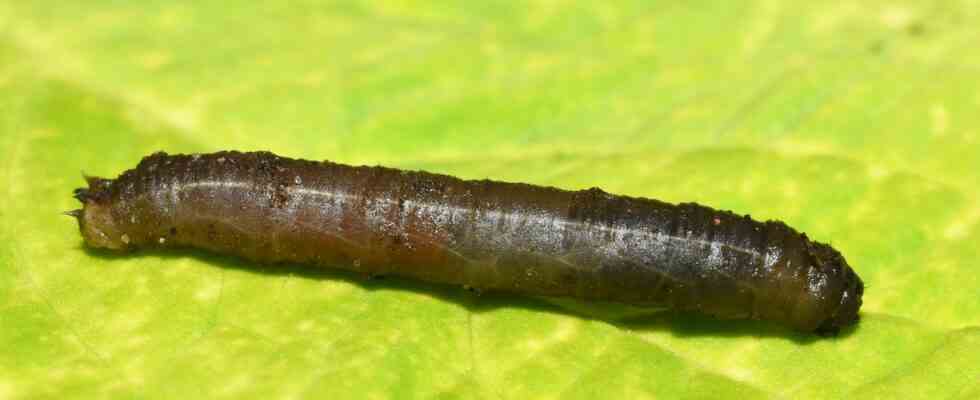crane fly
At the mention of crane flies, or cousins, images of these giant mosquitoes with long slender legs no doubt come to mind that it is not uncommon to come across in summer, whether in the garden or during walks in nature and rather in the morning or in the evening, because the leatherjacket prefers cool weather. Many of us do not like seeing these large insects, yet they are harmlessdo not bite and do not transmit diseases.
Unfortunately, the same is not true for their larvae which are gluttonous and can cause damage to plantations. In the larval state, this insect has a gray cylindrical body without legs and can, when mature, measure up to 4 or 5 cm. On this cylinder, it is even difficult to locate the head which can retract inside the thorax. At the end of their abdomen, you can spot 6 fleshy papillae, a distinctive sign that helps differentiate them from other kinds of worm. As a whole, their body is soft, but resistantand it can elongate.
The crane fly life cycle
The adult leatherjackets are especially visible in summer and it is not a coincidence: this is the period during which these insects mate and this, on several occasions. Female crane flies lay between 200 to 300 eggs per female between mid-August and early October. These black eggs are laid directly on the ground. After 2 weeks the eggs will hatch giving way to the larvae which will spend the winter in the ground and develop before rising to the surface to warm up.
They then eat everything they encounter on the way, i.e. roots and crowns of plants. Then when their development is complete, they turn into pupae and are therefore harmless. Then comes the pupation stage between May and August. A new cycle is ready to start again!
Damage caused by crane fly larvae
We have seen it is during their larval stage that leatherjackets cause the most damage to the garden, feeding on plant crowns, roots, but also the blades of herbaceous and grasses. They spare no plant and are generally most active in environments that benefit from constant humidity.
So you can see signs of a leatherjacket attack by the yellowing of certain areas of your lawn, generally the coolest ones, by the decline of some of your plants, whether vegetable or ornamental, by the appearance of dried spots on the leaves.
In addition, the massive presence of crane fly larvae can also attract insectivorous birds to your land, which, in turn, may cause damage, because by foraging the soil to find these larvae, they can harm your plantations. .
Interests in the garden
If leatherjackets can be considered as harmful in the sense that they destroy your plantations, they also have a role to play in your garden:
- Both in the adult and larval stages, they serve as bird food and batrachians.
- These detritivorous insects take part in the degradation of organic matter. Thus, they improve the fertility of your garden.
- Moreover, by digging galleries, the larvae also contribute to thesoil aeration.
How to fight against these pests?
You should know that it is not easy to fight against crane fly larvae. However, here are some steps you can take.
Limit watering
Remember that these larvae like a humid environment, which means that they will be sensitive to soil desiccation. To limit their presence, you must therefore strive to create an environment that they will not appreciate. To do this, make sure you have well-drained soil and limit repeated watering.
Use natural predators
To eliminate crane fly larvae, it is possible to have recourse to its natural enemies. You can, for example, install a chicken coop nearby in your garden. Why not release your hens in your vegetable garden before setting it up to take advantage of a good cleaning of the soil? In addition to getting rid of crane flies, their droppings will feed the soil. Less obvious, you can also try to attract hedgehogs, frogs, bats or moles which will feed on crane fly larvae.
The association of plants
To limit the presence of crane flies, it is also possible toassociate plants. You can, for example, cultivate a flower meadow or a lawn around your vegetable garden to protect it. Indeed, crane fly larvae will prefer meadows or grass to your plantations.
Apply nematodes
Against crane flies larvae, you can use nematodes. To do this, it is best to proceed between mid-September and mid-October, since this is the time when the eggs are laid and it is possible to control the larvae more effectively.
A biological treatment
It is possible to inoculate them with bacteria through nematodes Steinernema feltiae and S. carpocapsae. To do this, simply dilute the powder sachet of these nematodes in water and spray the area to be treated with this mixture.
A chemical treatment
Not recommended because of the consequences of this type of treatment on the environment and our health, there are nevertheless chemical treatments. These pellets will allow the destruction of the larvae.

